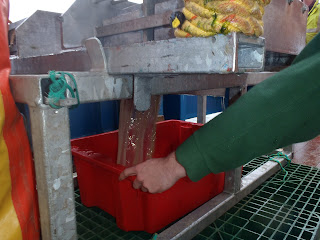The Hamon Grab is deployed over the side of the boat and lowered down to the seafloor where it takes a picture and a sample of the seafloor. It is then lifted back on board.
We then check to see if the grab has collected the sample and take it over to the outside lab. On the rare occasion that a sample is not collected, we give that site three attempts.
The content of the grab sample is then mixed and a sample of the sediment is taken for particle size analysis which occurs post survey.
We then measure the volume of the sample for macro fauna analysis, which will be up to 10 litres, as this is the maximum capacity of the Hamon Grab. A good grab sample will be over 4 litres in volume.
This sample is then passed through a 5mm and 1mm sieve to separate out the macrofauna, which at this site has mainly been worms, and occasionally a bivalve or starfish.
The sieved macrofauna are then panned and we then check that we have not missed any worms which may have got caught in the sieve mesh. The macrofauna sample is then placed into a labelled container for later analysis.
Though we have started to encounter some rough weather again, we are still making good progress with 96 stations completed. However, whilst the bad weather continues, we are now unable to safely deploy the Hamon Grab, so we shall therefore use this as an opportunity to collect some multibeam data.










